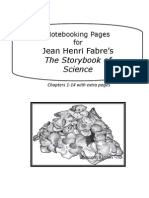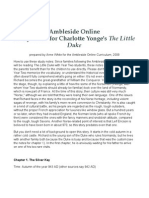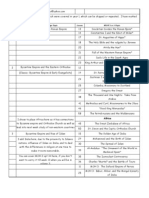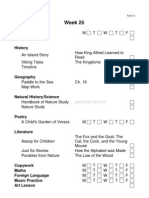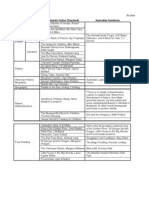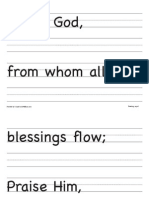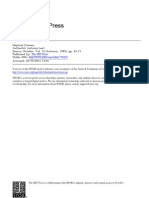Burgess Bird Book
Burgess Bird Book
Uploaded by
christiewCopyright:
Available Formats
Burgess Bird Book
Burgess Bird Book
Uploaded by
christiewOriginal Description:
Copyright
Available Formats
Share this document
Did you find this document useful?
Is this content inappropriate?
Copyright:
Available Formats
Burgess Bird Book
Burgess Bird Book
Uploaded by
christiewCopyright:
Available Formats
Burgess Bird Book Procedure
I know all the birds of the hills, and all that moves in the field is mine.
(Psalm 50:11)
Vision: Children will develop an appreciation and wonder for Gods creation.
Materials: Burgess Bird Book, field guide/picture of birds in chapter, chapter reference sheet listing which chapters to
read/notes. Optional: coloring sheets, paper, colored pencils, bird silhouette to fill in as reading
Procedure for scheduled reading weeks:
1. Review. See how much everyone remembers from the previous reading.
2. Read section aloud. Options for read aloud time:
Challenge children to listen carefully to reading to see if they can make a picture in their mind about how the
bird looks and acts based on the descriptions. Show a picture of the bird AFTER the narration. (Good practice
for visualizing.) When first starting this, or for those who might benefit, give a general bird shape that they can
color in as description is read. After reading, check it against the bird guide and correct as needed.
Look up bird in field guide. Look at picture while listening to selection being read aloud.
o As listening, look at picture and try to spot any of the birds features described.
Coloring pages while listening.
3. Narrate. (Narrate orally or could choose to narrate by drawing the bird in detail.)
Oral: Frame narration as, Tell me what you learned about {bird} rather than Narrate this chapter to focus
narration more on the birds than the storyline. They can choose to answer one or more of the following
questions as a guide.
What does the bird look like? What does it eat? What kind of nest does it build? Where might we
expect to see one?
Drawing: Draw picture of bird with details. (Bind together into book at end of year.)
Note: If struggling with narration, stop more frequently. Pause after reading description of bird for narration
about bird.
4. If didnt look up bird in field guide, look up and compare picture described or drawn with guide.
Non-reading week ideas (optional), or as kids are interested:
1. Review. See how much remember from the previous reading.
2. Coloring sheet or drawing if havent done. (Play composer music in background.)
3. Cut out coloring sheet or drawing and hang on paper tree. (Talk about various birds sporadically.)
4. Listen to bird calls (www.allaboutbirds.org)/ YouTube videos.
5. On another day, do picture study like exercise. Look at picture of bird and have child close eyes and tell as much about
the bird as can while picturing it in mind. (Optional: Say name and reread the sentences in chapter that describe bird,
nest, diet, etc. before doing this.)
6. Play memory game or Guess Who? game (describe pic, traits & others guess) with bird pictures.
Other ideas:
If struggling w/ recall, replace character names (Blacky the Crow) w/ just bird name (Mr. Crow).
When reading, have pictures of birds available (draw on index cards, print outs, etc.) and point to appropriate picture
when referencing a character. Use pictures for narration/ to act out story.
Coloring pages & http://www.animalstown.com/animals/j/junco/coloring-pages/junco-coloring-01.php
Prep:
Readings: Six chapters/term (18 total), every other week. Continue rest as free read if want.
Selecting chapters: Choose birds most likely to see, then a variety of categories of birds (ex hawks, woodpeckers,
goose, etc.) and ones that deal with common bird traits (ex migration; Chap. 16 & 17, The Robber in the Orchard
and More Robbers, deal w/protecting eggs from predators)
Note that the AO website suggests choosing chapters appropriate to seasons/location, but there is some continuity
from one chapter to next and references to birds introduced in earlier chapters, so if possible, plan chapters in order.
Book runs spring -> winter (which can make a fall -> spring school year a little more difficult to schedule, or start
earlier).
You might also like
- The Storybook of Science Notebook PagesDocument46 pagesThe Storybook of Science Notebook PagesNorth Laurel100% (12)
- AO Weekly Schedule Year 1Document3 pagesAO Weekly Schedule Year 1Catie100% (10)
- Narration CubeDocument1 pageNarration CubeAmblesideOnline100% (4)
- Afro Surrealism PDFDocument3 pagesAfro Surrealism PDFBill TolesNo ratings yet
- A Philosophy of Education Study Guide Rachel LebowitzDocument77 pagesA Philosophy of Education Study Guide Rachel LebowitzAurora Hestia100% (1)
- Ambleside Online Year 1 Checklist For LiteratureDocument5 pagesAmbleside Online Year 1 Checklist For Literatureraisingcain100% (11)
- Burgess Animal Book Illustrations PT 1Document4 pagesBurgess Animal Book Illustrations PT 1laurke100% (4)
- Online Read AloudsDocument1 pageOnline Read AloudsAmblesideOnlineNo ratings yet
- Mother Culture: Art Music Nature Poetry Great Books Bible SpanishDocument10 pagesMother Culture: Art Music Nature Poetry Great Books Bible Spanishalaw81100% (1)
- Parent Guide For Nature StudyDocument24 pagesParent Guide For Nature StudyRon-Natalie Sing100% (4)
- BFSU BookListDocument9 pagesBFSU BookListMischa SmirnovNo ratings yet
- Big Picture ChartDocument32 pagesBig Picture ChartTori Prophet100% (4)
- Converging Lenses Experiment ReportDocument4 pagesConverging Lenses Experiment ReportCarli Peter George Green100% (1)
- Term Schedule Year 0Document1 pageTerm Schedule Year 0Catie100% (1)
- Mater Amabilis Level 1B, Year 1 SyllabusDocument7 pagesMater Amabilis Level 1B, Year 1 SyllabusSharon Orzechowski WeilNo ratings yet
- Narration StartersDocument7 pagesNarration StarterscreativemommyNo ratings yet
- Singing InstructionDocument2 pagesSinging InstructionAmblesideOnlineNo ratings yet
- AO Little Duke NotesDocument16 pagesAO Little Duke NotesNikki OwensNo ratings yet
- Music InstructionDocument4 pagesMusic InstructionAmblesideOnlineNo ratings yet
- Robyn - Intro To Her Planning PagesDocument5 pagesRobyn - Intro To Her Planning Pageslaurke100% (3)
- Burgess Animal Book Illustrations PT 2Document4 pagesBurgess Animal Book Illustrations PT 2laurkeNo ratings yet
- Riley Year 5 Daily ChecklistDocument2 pagesRiley Year 5 Daily ChecklistgreenebaltsNo ratings yet
- All About Birds - Basic Bird Study Notebooking PagesDocument58 pagesAll About Birds - Basic Bird Study Notebooking Pageshannah.r-w7784100% (2)
- BirdSleuth Explorer Guidebook Teachers and Families 1Document12 pagesBirdSleuth Explorer Guidebook Teachers and Families 1lavricsilviaNo ratings yet
- Burgess Animal Book Illustrations PT 3Document4 pagesBurgess Animal Book Illustrations PT 3laurke100% (1)
- Spring Nature StudyDocument24 pagesSpring Nature StudyRon-Natalie Sing100% (1)
- Plans For My Year: Family History, Geography, BibleDocument2 pagesPlans For My Year: Family History, Geography, Bibleumm_aasiyaNo ratings yet
- Tapestry Year 2 With MOH 2 and 3Document6 pagesTapestry Year 2 With MOH 2 and 3Julieanne MillerNo ratings yet
- Charlotte Mason Style ScheduleDocument2 pagesCharlotte Mason Style ScheduleKristen BrevoortNo ratings yet
- Year 1 Term 3 ChecklistDocument12 pagesYear 1 Term 3 ChecklistEmmaNo ratings yet
- Ambleside Online Year 1 Checklist For PoetryDocument3 pagesAmbleside Online Year 1 Checklist For Poetryraisingcain100% (2)
- Year 1 Checklist - AUDocument47 pagesYear 1 Checklist - AUEmma100% (2)
- Weekly Workbox Assignment SheetDocument2 pagesWeekly Workbox Assignment SheetTori Prophet100% (1)
- CM Side by Side ComparisonDocument8 pagesCM Side by Side Comparisonjanebabes100% (1)
- Cycle 1 Week 13 Fine Arts Giotto Di Bondone Saint PaulDocument2 pagesCycle 1 Week 13 Fine Arts Giotto Di Bondone Saint PaulAnonymous OFaj5D3BNo ratings yet
- TQ Guides W Heo-Ao Years - ChartDocument1 pageTQ Guides W Heo-Ao Years - ChartAmblesideOnlineNo ratings yet
- How To Use Mcguffey ReadersDocument2 pagesHow To Use Mcguffey ReadersMartin NacevNo ratings yet
- Ambleside Online Brochure 2008 Double-Sided Tri-FoldDocument2 pagesAmbleside Online Brochure 2008 Double-Sided Tri-FoldAmblesideOnlineNo ratings yet
- Schedules - For Little OnesDocument3 pagesSchedules - For Little OnesAmblesideOnlineNo ratings yet
- Henry Ossawa Tanner Picture Study AidDocument24 pagesHenry Ossawa Tanner Picture Study AidSarah P100% (1)
- Finishing Up Year 1Document1 pageFinishing Up Year 1CatieNo ratings yet
- Robyn's Year 5 PlannerDocument5 pagesRobyn's Year 5 Plannerlaurke100% (1)
- Course of Study Grade 2Document2 pagesCourse of Study Grade 2As For Me And My HomeNo ratings yet
- Winnie The Pooh and Some Bees CopyworkDocument17 pagesWinnie The Pooh and Some Bees CopyworkMyrna Soledad QuintanaNo ratings yet
- History Book of CenturiesDocument125 pagesHistory Book of Centuriesgsnapnc100% (1)
- My Book of Centuries: NameDocument10 pagesMy Book of Centuries: NameBrandy Campbell100% (1)
- 3rd Grade Booklist - 12 - 13Document4 pages3rd Grade Booklist - 12 - 13MySymphonyNo ratings yet
- Praise God, From Whom All: Doxology, Page 1Document5 pagesPraise God, From Whom All: Doxology, Page 1Virna LassiterNo ratings yet
- Level 1B Nature StudyDocument7 pagesLevel 1B Nature Studybwalsh1No ratings yet
- Reading LessonsDocument36 pagesReading LessonsAmblesideOnline100% (1)
- OIS Monarch Timeline CardsDocument8 pagesOIS Monarch Timeline Cardslaurke100% (3)
- Ambleside Online A Formidable List of Attainments For A Child of Six ChecklistDocument6 pagesAmbleside Online A Formidable List of Attainments For A Child of Six Checklistraisingcain100% (4)
- Charlotte Mason Style Long Term PlannerDocument1 pageCharlotte Mason Style Long Term PlannerSommer SchlagelNo ratings yet
- Primary Arts of Language - Reading TeacherÕs Manual - Jill Pike - 2012 - Institute For Excellence in Writing - 9780983297901 - Anna's ArchDocument204 pagesPrimary Arts of Language - Reading TeacherÕs Manual - Jill Pike - 2012 - Institute For Excellence in Writing - 9780983297901 - Anna's ArchJessica Diaz GuadalupeNo ratings yet
- Our Island Story 1-21Document21 pagesOur Island Story 1-21laurkeNo ratings yet
- Teaching Kids Shakespeare William Shakespeare Lesson PlanDocument3 pagesTeaching Kids Shakespeare William Shakespeare Lesson PlanIvy TohNo ratings yet
- Level 1 SN Sample Units 1 and 2Document27 pagesLevel 1 SN Sample Units 1 and 2Pepo HernandezNo ratings yet
- Hymn Cards 2011 2012Document24 pagesHymn Cards 2011 2012AmblesideOnline100% (1)
- Australian Variations Ambleside Online (Standard)Document43 pagesAustralian Variations Ambleside Online (Standard)EmmaNo ratings yet
- Parables from Nature: "Illustrated Four Series in One Book"From EverandParables from Nature: "Illustrated Four Series in One Book"Rating: 5 out of 5 stars5/5 (1)
- Morning Basket Fall 2016Document4 pagesMorning Basket Fall 2016christiew0% (1)
- Our Routine: Morning Chores and Zone Check Breakfast and Family DevotionsDocument2 pagesOur Routine: Morning Chores and Zone Check Breakfast and Family DevotionschristiewNo ratings yet
- Burgess Bird Book Alphabetical List of Birds - FloridaDocument3 pagesBurgess Bird Book Alphabetical List of Birds - FloridachristiewNo ratings yet
- Bird OutlinesDocument10 pagesBird OutlineschristiewNo ratings yet
- Meal Rotations: "Taste and See That The Lord Is Good.... "Document2 pagesMeal Rotations: "Taste and See That The Lord Is Good.... "christiewNo ratings yet
- Casey A Wood Collection 2Document47 pagesCasey A Wood Collection 2Supesala RajapakshaNo ratings yet
- Pioneer Pre-Intermediate Tests Module 2Document5 pagesPioneer Pre-Intermediate Tests Module 2Tünde Porcsalmy100% (1)
- ARES Field Guide No. 1 Identifying Tracing The FN Herstal FAL RifleDocument31 pagesARES Field Guide No. 1 Identifying Tracing The FN Herstal FAL Riflemalone69No ratings yet
- Amateur PhotographerDocument92 pagesAmateur PhotographerSanjay BhagwatNo ratings yet
- Introduction To ExcelDocument87 pagesIntroduction To ExcelSsekiwere BrunoNo ratings yet
- 12 Principles of AnimationDocument7 pages12 Principles of AnimationSean BustosNo ratings yet
- Simple Chunky Knit Hat PDFDocument2 pagesSimple Chunky Knit Hat PDFSimona TuderașcuNo ratings yet
- The Fall of Iron CurtainsDocument59 pagesThe Fall of Iron CurtainsMarco TumaNo ratings yet
- 03 Laboratory Exercise 1Document4 pages03 Laboratory Exercise 1youare3ternalNo ratings yet
- Facebook Monet TemplateDocument3 pagesFacebook Monet Templateapi-97402456No ratings yet
- DMU Navigator Por DiegoDocument549 pagesDMU Navigator Por DiegoiagomouNo ratings yet
- Challenging The NarcissistDocument8 pagesChallenging The Narcissistveralynn35100% (1)
- Omnivision II Operation English 45721 0215 CCv0001Document144 pagesOmnivision II Operation English 45721 0215 CCv0001Luiza Espino50% (2)
- Tender Evaluation Criteria - MaroverDocument57 pagesTender Evaluation Criteria - Maroverapi-355937803No ratings yet
- Final Project ADocument16 pagesFinal Project Aapi-289083087No ratings yet
- "This Is It" Announcement Draft Sony/MJ Estate Working Together On Manipulating TruthDocument3 pages"This Is It" Announcement Draft Sony/MJ Estate Working Together On Manipulating TruthEdward SheltonNo ratings yet
- Megawords Book Shop: The Art of Not Being GovernedDocument9 pagesMegawords Book Shop: The Art of Not Being Governedagl7k8tNo ratings yet
- Pinholehasselblad PDFDocument8 pagesPinholehasselblad PDFYanina Arizaga80% (5)
- Visual Designing Apps and ToolsDocument3 pagesVisual Designing Apps and ToolsFabul, Azaliah Krezhane VillanuevaNo ratings yet
- Innovation Management and Entrepreneurship Nov 21 2024Document51 pagesInnovation Management and Entrepreneurship Nov 21 2024Marcus HollowayNo ratings yet
- Profile Photo GuideDocument2 pagesProfile Photo GuidekjfdNo ratings yet
- AC7 Manual Rev5Document39 pagesAC7 Manual Rev5esentertainmentNo ratings yet
- Thin LensesDocument1 pageThin LensesJumar CadondonNo ratings yet
- Opencv TutorialsDocument113 pagesOpencv TutorialsPiyush GuptaNo ratings yet
- Quest 5 Tema 2Document6 pagesQuest 5 Tema 2ElenaNo ratings yet
- Haptical CinemaDocument30 pagesHaptical CinemagreggflaxmanNo ratings yet
- Nepal Open University: Faculty of Management and Law Office of The Dean Final ExaminationDocument4 pagesNepal Open University: Faculty of Management and Law Office of The Dean Final ExaminationChintamani GiriNo ratings yet
- Service Manual 100712Document42 pagesService Manual 100712adavit73No ratings yet
